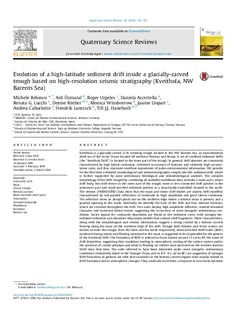| dc.description.abstract | Kveithola is a glacially-carved, E-W trending trough located in the NW Barents Sea, an epicontinental shelf sea of the Arctic Ocean located off northern Norway and Russia. A set of confined sediment drifts (the “Kveithola Drift”) is located in the inner part of the trough. In general, drift deposits are commonly characterized by high lateral continuity, restricted occurrence of hiatuses and relatively high accumulation rates, and thus represent excellent repositories of paleo-environmental information. We provide for the first time a detailed morphological and seismostratigraphic insight into this sediment drift, which is further supported by some preliminary lithological and sedimentological analyses. The complex morphology of the drift, imaged by combining all available multibeam data, includes a main and a minor drift body, two drift lenses in the outer part of the trough, more or less connected drift patches in the innermost part and small perched sediment patches in a structurally-controlled channel to the north. The seismic (PARASOUND) data show that the main and minor drift bodies are mainly well-stratified, characterized by sub-parallel reflections of moderate to high amplitude and good lateral continuity. The reflectors show an abrupt pinch-out on the northern edge where a distinct moat is present, and a gradual tapering to the south. Internally we identify the base of the drift and four internal horizons, which we correlate throughout the drift. Two units display high amplitude reflectors, marked lensoidal character and restricted lateral extent, suggesting the occurrence of more energetic sedimentary conditions. Facies typical for contourite deposition are found in the sediment cores, with strongly bioturbated sediments and abundant silty/sandy mottles that contain shell fragments. These characteristics, along with the morphological and seismic information, suggest a strong control by a bottom current flowing along the moat on the northern edge of the drift. Though both Atlantic and Arctic waters are known to enter the trough, from the west and the north respectively, brine-enriched shelf water (BSW) produced during winter and flowing westward in the moat, is suggested to be responsible for the genesis of the Kveithola Drift. The formation of BSW is inferred to have started around 13 cal ka BP, the onset of drift deposition, suggesting that conditions leading to atmospheric cooling of the surface waters and/or the presence of coastal polynyas and wind or floating ice shelves have persisted on the western Barents Shelf since that time. The units inferred to have been deposited under more energetic sedimentary conditions (tentatively dated to the Younger Dryas and to 8.9–8.2 cal ka BP) are suggestive of stronger BSW formation. In general, we infer that variations in the bottom current regime were mainly related to BSW formation due to atmospheric changes. They could also have been a response to successive episodes of grounded and sea ice retreat that allowed for a first limited, later open shelf current, which progressively established on the western Barents Sea shelf. | nb_NO |

